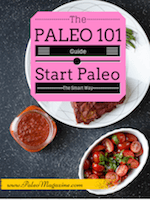Is Gluten-Free Bread Paleo? 6 Problems To Consider (+ Downloadable Recipe)
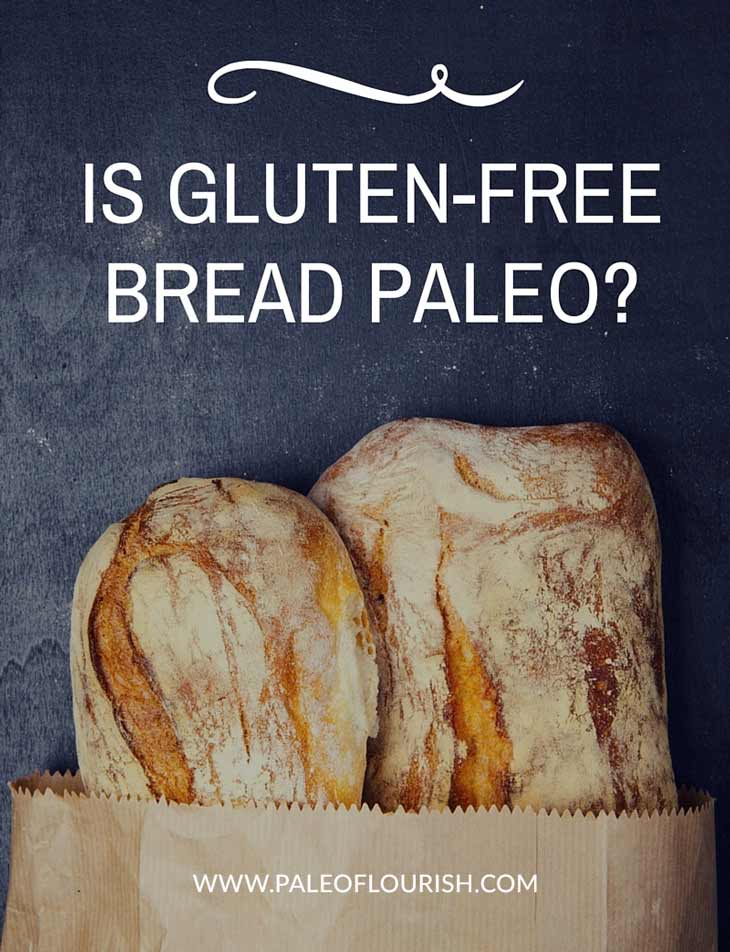
With the popularity of gluten-free going crazy worldwide, it’s no wonder people are getting confused about whether they should be eating gluten-free products like gluten-free bread on a Paleo diet. So, is gluten-free bread Paleo? Is gluten-free bread good for you? That’s what we’ll explore in this article.
Is Gluten-Free Bread Paleo? – Table of Contents
- What Is Gluten-Free Bread?
- What Is Gluten-Free Bread Made From?
- Is Gluten-Free Bread Paleo?
- 6 Problems With Gluten-Free Breads
- Is Gluten-Free Bread OK To Eat Occasionally?
- Download Our Paleo Bread Recipe Here…
What Is Gluten-Free Bread?
Basically, gluten-free bread is any bread made with gluten-free ingredients. This can of course include Paleo breads made from almond flour (like this Paleo microwave bread recipe or this Paleo oven bread recipe or any of these Paleo bread recipes). OR, it can be a non-Paleo bread made from gluten-free flours like rice flour, teff flour, corn meal, tapioca starch, and potato starch.
One of the complications of answering this question is because any foods that are Paleo are by definition also gluten-free, but unfortunately, the reverse is NOT true. See this article on Paleo vs Gluten-Free for more clarification on this issue.
So, for purposes of this article, I’m going to talk about gluten-free breads that are not also Paleo.
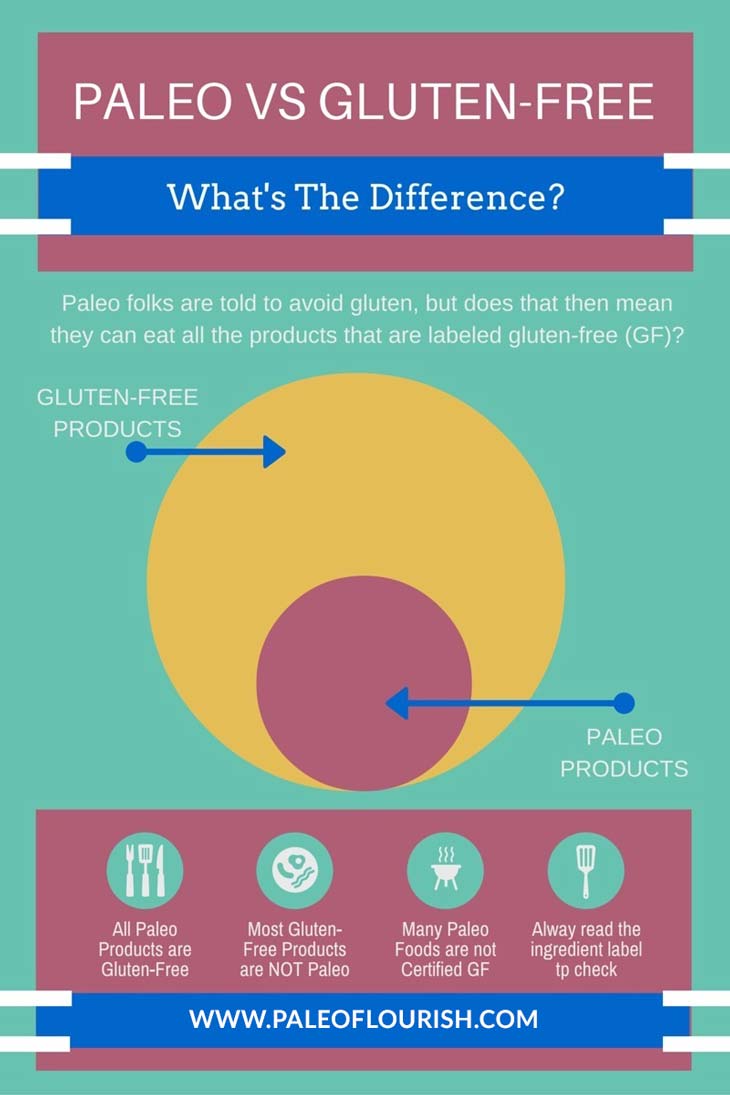
What Is Gluten-Free Bread Made From?
Apart from a gluten-free flour like rice flour, most store-bought gluten-free bread also contains a whole host of other non-Paleo ingredients.
Take this popular gluten-free bread – Udi White Sandwich Bread. Its ingredients are: water, tapioca starch, brown rice flour, canola oil, egg whites, potato starch, modified food starch, tapioca maltodextrin, dried cane syrup, tapioca syrup, yeast, gum (xanthan gum, sodium alginate, guar gum), salt, locust bean gum, cultured corn syrup solids and citric acid (mold inhibitor), enzymes
Here’s another brand of gluten-free bread – Rudi’s Multigrain Gluten-Free Bread. Its ingredients are: water, potato extract, Non-GMO and expeller pressed canola oil*, rice starch, rice flour, evaporated cane syrup, inulin, bamboo fiber, honey, sea salt, molasses, egg whites, cornmeal, sunflower seeds, flaxseed, millet, yeast, xanthan gum, distilled vinegar, natural enzymes.
And one last brand – Canyon Bakehouse Gluten-Free Mountain White Sandwich Bread. Its ingredients are: water, brown rice flour, tapioca flour, organic agave syrup, whole grain sorghum flour, cultured rice flour, organic cane sugar, xanthan gum, extra virgin olive oil, eggs, organic sustainable palm fruit oil, sea salt, yeast, enzymes.
Is Gluten-Free Bread Paleo?
Short Answer – No, Most Gluten-Free Breads are NOT Paleo.
Basically, if the bread contains non-Paleo ingredients, then it’s not Paleo. There are of course some gluten-free breads made from Paleo ingredients (like those recipes mentioned above), and those would be considered OK for a Paleo diet (although we do not recommend you rely on them or eat them daily!).
If you’re asking the question, “is gluten-free bread paleo,” then you’re probably not too happy with our answer! So, let’s go into a bit more depth about the problems with many gluten-free breads that you can purchase in stores.
6 Problems With Gluten-Free Breads
Here are some of the problems with many brands of gluten-free breads sold in stores:
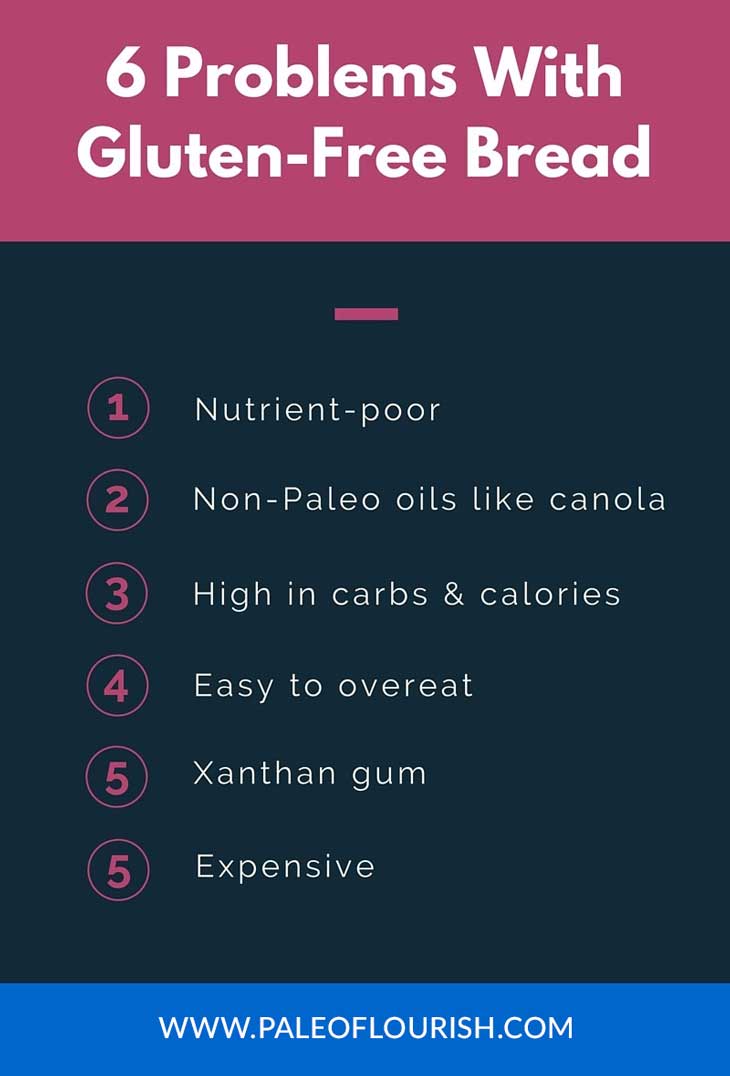
1. Gluten-free breads are just empty calories.
The ingredients are usually several types of starchy flours (like rice flour, tapioca flour, potato starch) that have minimal minerals and vitamins and a slew of different sugars (like evaporated cane syrup, honey, agave syrup, cane sugar, tapioca syrup, dried cane syrup).
2. Some brands of gluten-free breads contain non-Paleo oils like canola oil.
This post explains some of the problems with seed and vegetables oils like canola.
3. Gluten-free breads are not good for weight-loss.
Many people start a Paleo diet because they want to lose weight. Unfortunately, eating gluten-free breads is not going to help with weight-loss. They’re calorie-dense and very poor in nutrients.
4. Can be easy to overeat.
With that much sugar and refined carbohydrates in many gluten-free breads, they can be very easy to overeat. And it’s easy to fool yourself into thinking that you’re eating something “healthy” and therefore get into a habit of eating them all the time.
5. Many brands contain xanthan gum.
Xanthan gum is a binding agent that can cause digestive issues for some people.
6. Expensive
This isn’t a negative necessarily – there are good reasons for why gluten-free bread costs more than regular bread to make. But, eating gluten-free breads can be taxing on your budget when there are often more nutritious and cheaper foods (e.g., eggs for breakfast!).
Is Gluten-Free Bread Better Than Regular Bread?
It’s often easy to trick yourself into thinking you’re eating something healthy when you’re really not. While gluten-free bread sounds healthy, it’s really not – it’s loaded with ingredients that offer very few nutrients.
How does gluten-free bread compare with regular bread then? If you’re celiac, then clearly regular bread is out of the question. But if you’re not celiac or gluten-sensitive, then could you get away with eating some regular bread instead?
Unfortunately, regular bread is no healthier than gluten-free bread. While freshly made bread usually contain fewer ingredients than those store-bought gluten-free breads mentioned above, the fact remains that the gluten in bread can cause problems for people even if you don’t notice it right now. Plus, even regular bread usually contains sugar, and wheat flour is a high glycemic load ingredient that isn’t any better for you than rice flour.
Is Gluten-Free Bread OK To Eat Occasionally?
Our recommendation is to try not to eat gluten-free bread. We know for practical reasons, it may not be possible when you’re traveling or on holiday as it can be tough to find Paleo foods.
Our suggestion for those times is to make sure you know in your mind that eating that gluten-free sandwich is going to be a one-off event. One mistake we often see is that people eat one thing that isn’t Paleo, and then they go off on a huge binge (“because heck, if I’m already breaking the rules, then I might as well go the whole way”). A few days later, the guilt kicks in, but it’s tough to pull back and restart. What we’ve found works better is to consciously choose to eat something that may not be all that great for you but to also consciously choose to only eat that one thing.
Download our Paleo bread recipe here
Bread is something we’re all so used to eating that it’s tough to say no to. So, when moving to a Paleo diet, it can be helpful to make some recipes like microwave Paleo bread to help with the adjustment.
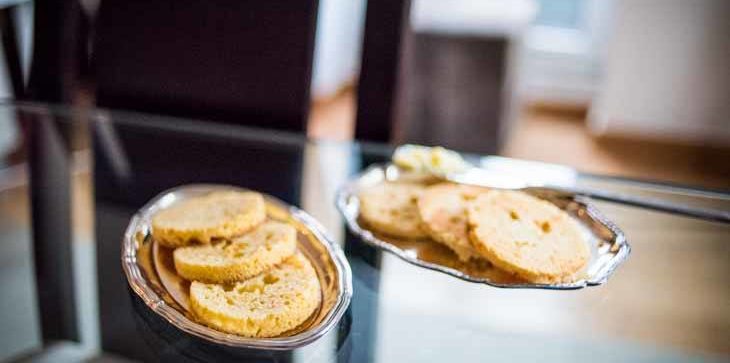
For a larger list of Paleo bread recipes (most of which don’t use the microwave and can be made in bigger batches), check out our giant list here.
However, we highly suggest you don’t make any form of bread a regular part of your diet. Start enjoying other foods – you might discover something else delicious!
Images: Copyright (c) irinagrigorii from Fotolia

